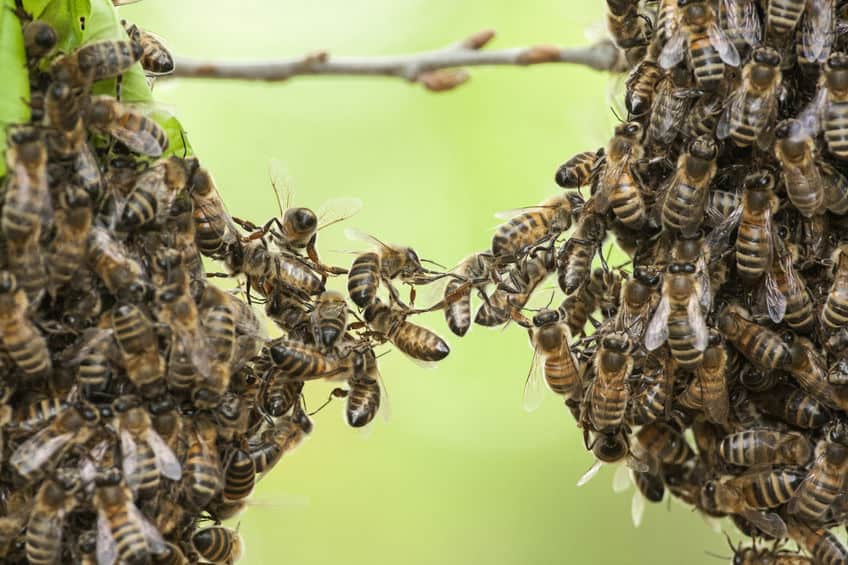Honey bees will swarm when they leave a nest to establish a new one. Reasons for this can include lack of forage, an overcrowded hive, disease, or pesticide use in the area.
Lack of food means that the workers won’t be able to bring in enough nectar and pollen to survive the winter, so the hive uproots itself and seeks out a new home where food may be more plentiful. With overcrowded hives, too many bees in too small a space create issues in that there may not be enough food to feed them all, and disease can run rampant on the crowded frames. In these situations, the queen will usually lay eggs in queen cells in order to replace her, and then depart with half of her colony. Known as “splitting”, this method allows a better chance of survival for the colony that stays put, rather than risk the entire population.
Disease and pesticides create a similar response in the hive; the queen and the healthy workers will depart, leaving behind those who are sick and dead. This prevents disease from spreading into the healthy individuals, and allows them to escape from the pesticide-sprayed areas. Normally honey bees are very hygienic and will clean one another thoroughly to prevent the introduction of pests such as the varroa mite, but if disease can get a stronghold on the hive then their best option is to leave.

Do bees swarm at a particular time of year?
Although it can happen at any time of the year outside of winter, the most common time is between late spring and early summer. This coincides with when the flowering season is at a peak, and nectar flow is high. The queen is typically laying lots of eggs at this point, so the combination of lots of bees in the hive along with lots of honey coming in means two things: the hive starts to get crowded with bees, and the queen begins to run out of places to lay eggs when too much honey is present. Beekeepers have to be diligent during this time, making sure that hives have enough room to expand into.
Is swarming risky for bees?
Swarming is a survival tactic for honey bees, but unfortunately it’s not very successful. Some reports claim that less than 80% of swarms survive. This is especially true for North America, where honey bees are not native. Finding a habitat and building a full hive in time for winter is arduous work that takes all year, and the later in the year that a swarm leaves the hive, the less likely it is to make it.
Is swarming a danger to people?
Bee swarms aren’t typically aggressive; they don’t have a hive to protect. That said, swarms are best left to be dealt with by a beekeeper than the average person. They can still be defensive if someone gets too close or tries provoking the swarm. Swarms will usually move from place to place before finding a final place to call home, so seeing a mass of honey bees on a fence post doesn’t necessarily mean they’re going to make a hive right there, and can be safely ignored until the bees leave if a beekeeper isn’t immediately available.
Do all bees swarm?
The act of swarming has only been observed in Apis species, which are all honey bees. Since the majority of bee species are solitary, there is no colony to uproot and swarm away together to find a new home. Most social bee colonies also number far fewer than that of the honey bee, so issues that the honey bee deals with are not as prevalent in other species. Varroa mite, for instance, only targets two species of Apis.
Do wasps also swarm?
Between a “swarm of bees” and a “swarm of wasps”, the latter certainly sounds more intimidating, and for good reason; bees will swarm when they are in search of somewhere new to live, whereas wasps will swarm to defend their nest when it has been attacked or damaged. Paper wasps and yellowjackets also have another type of swarm in which they gather in large numbers in order to mate. These swarms are less dangerous but should be well avoided; their smooth stingers allow them to sting multiple times. Warrior wasps are also known to swarm if their nest is destroyed by army ants.
